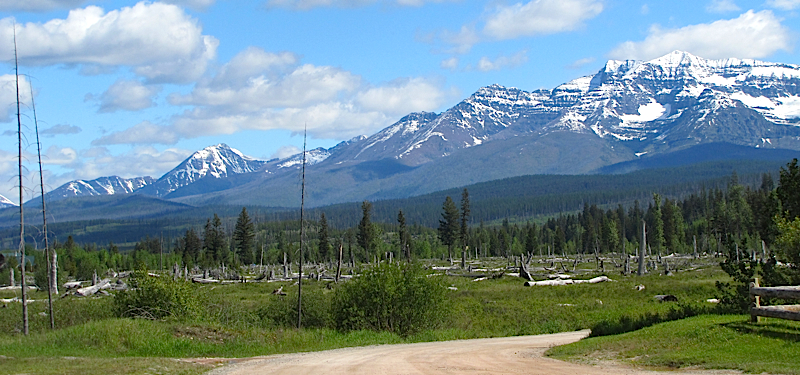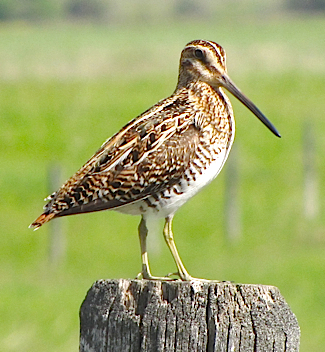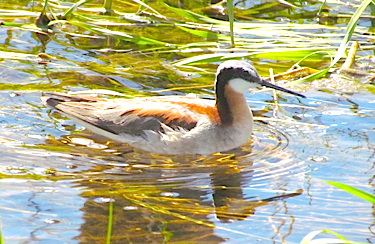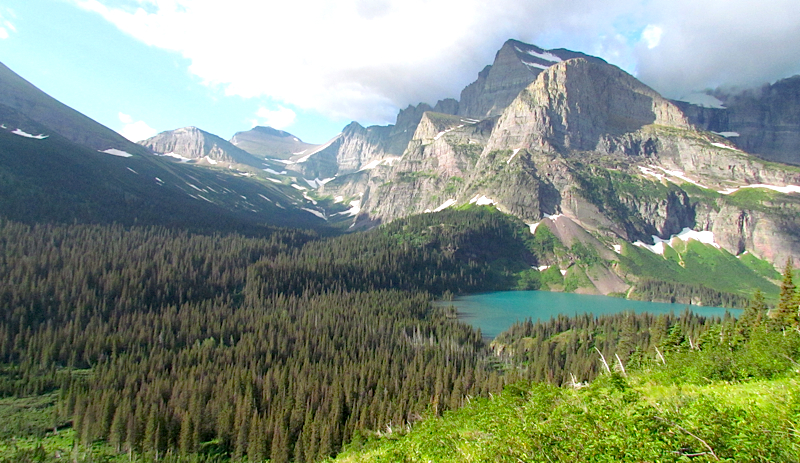For our tour description, itinerary,
past triplists, dates, fees, and more, please VISIT OUR TOUR PAGE.
See this triplist in printable PDF format with media only on
page 1.

Does Montana really
possess the most spectacular scenery in the lower 48? This
photo by tour participant Pat Newman certainly supports that
position, but why not take the tour yourself and form your
own opinion?
This is one of the greatest scenic wildlife trips in North
America. On this trip, everywhere we look are incredible
mountains and picturesque valleys coupled with abundant
wildlife, including both birds and mammals. Yellowstone
National Park is the biggest draw for the visitor and
rightfully so, for if not for the geothermal features
(geysers, hot springs, fumaroles, mudpots, and frying pans) it
would be like most mountain areas of the Rocky Mountain West.
But Yellowstone is also special for other reasons and is
teeming with wildlife; the Yellowstone experience is one not
to be forgotten anytime soon.
Then there is the less well-known Glacier National Park,
which is purely magical to the human psyche, with an abundance
of snow meltwater, hanging waterfalls, glaciers and
snowfields, tall trees and colorful wildflowers, and an
accompanying complement of birds and mammals.
But few visitors have experienced the areas in between these
two magnificent national parks. We traveled this
off-the-beaten path, because we know it personally by having
lived and worked in these out-of-the-way places that few
visitors (and even Montana residents!) have seen.
It was quite the trip, covering 1850 miles in 9 days. We
crossed twelve high-elevation mountain passes, including
crossing the Continental Divide on eight separate occasions.
Most surprising was the fact that we traveled from the Arctic
drainage to the Atlantic drainage to the Pacific drainage all
within a four-hour period!
In all, we tallied 184 species of birds and 26 species of
mammals. Highlight birds included: Boreal Chickadee, Black
Swift, Sage Sparrow, Alder and Gray flycatchers, McCown’s and
Chesnut-collared longspurs, and Short-eared and Burrowing
owls. Our mammal list was equally impressive with Gray Wolves,
Grizzlies, Moose, Mountain Goats, and Bighorn Sheep topping
the charts for large mammals, while the rare Pygmy Rabbit won
the prize by far for the top small mammal.
Our fondest bird memories included two beautifully-clad,
breeding-plumaged Harlequin Duck drakes playing and feeding in
a pattern by flying upstream, then descending and kayaking the
Yellowstone River through a turbulent cascade only to repeat
the process. We also watched a Golden Eagle performing an
undulating territorial display in Glacier National Park. And
we observed two Burrowing Owls sticking their heads out of a
badger hole, not to mention incredible views of perched and
flying Short-eared Owls at close range. The remarkable
parachuting displays of the McCown’s Longspur will be etched
in our minds. And of course a pale female Merlin, of the Great
Plains or Prairie race (F.c. richardsonii), carrying a
Brewer’s Blackbird was yet another highlight.
Our fondest memories of watching mammals, many with newborn
young, included close views of adult Gray Wolves on two
occasions. We found seven Grizzlies, including a rare sighting
of a sow with a cub that ventured onto the plains from the
Rocky Mountain Front. We also found what is becoming rare in
Montana these days--Moose! We saw two in Yellowstone, eight on
the Rocky Mountain Front, and closer-than-expected views of
two in Glacier.
The Field Guides 2012 Yellowstone to Glacier tour was a
smashing success, much in part due to mother nature, the
cooperating weather, and a fun group of adventurous travelers
seeking a unique experience. It was a pleasure for John and me
to guide you from Yellowstone to Glacier, to the
off-the-beaten-path places, and for the wildlife, skyscapes,
and landscapes that we fondly symbolize and call Montana (the
Big Sky state). Thanks for traveling with Field Guides!
--Terry
KEYS FOR THIS LIST
One of the following keys may be shown in brackets for
individual species as appropriate: * = heard only, I =
introduced, E = endemic, N = nesting, a = austral migrant, b =
boreal migrant
Anatidae (Ducks, Geese, and Waterfowl)

After a session
of shooting the rapids in the torrential Yellowstone
River, two male Harlequin Ducks take a break and
contemplate another run. (Photo by guide Terry McEneaney)
CANADA GOOSE (Branta canadensis)
[N]
TRUMPETER SWAN
(Cygnus buccinator) [N]
WOOD DUCK (Aix sponsa)
GADWALL (Anas strepera) [N]
AMERICAN WIGEON
(Anas americana) [N]
MALLARD (Anas platyrhynchos) [N]
BLUE-WINGED TEAL
(Anas discors)
CINNAMON TEAL
(Anas cyanoptera)
NORTHERN SHOVELER
(Anas clypeata)
NORTHERN PINTAIL
(Anas acuta)
GREEN-WINGED TEAL
(AMERICAN) (Anas crecca
carolinensis)
CANVASBACK
(Aythya valisineria)
REDHEAD (Aythya americana)
RING-NECKED DUCK
(Aythya collaris)
LESSER SCAUP
(Aythya affinis)
HARLEQUIN DUCK
(Histrionicus histrionicus)
BUFFLEHEAD
(Bucephala albeola)
COMMON GOLDENEYE
(Bucephala clangula)
BARROW'S GOLDENEYE
(Bucephala islandica)
COMMON MERGANSER
(Mergus merganser)
RUDDY DUCK
(Oxyura jamaicensis)
Phasianidae (Pheasants, Grouse, and
Allies)

A prairie
fencepost makes an excellent perch for a Wilson's Snipe
between performances of its winnowing display flight.
(Photo by tour participant Pat Newman)
RING-NECKED PHEASANT (Phasianus colchicus) [I]
WILD TURKEY
(Meleagris gallopavo) [I]
Gaviidae (Loons)
COMMON LOON (Gavia immer)
Podicipedidae (Grebes)
PIED-BILLED GREBE (Podilymbus podiceps)
HORNED GREBE
(Podiceps auritus)
RED-NECKED GREBE
(Podiceps grisegena) [N]
EARED GREBE
(Podiceps nigricollis) [N]
WESTERN GREBE
(Aechmophorus occidentalis) [N]
CLARK'S GREBE
(Aechmophorus clarkii)
Phalacrocoracidae (Cormorants and Shags)
DOUBLE-CRESTED CORMORANT (Phalacrocorax auritus) [N]
Pelecanidae (Pelicans)
AMERICAN WHITE PELICAN (Pelecanus erythrorhynchos)
Ardeidae (Herons, Egrets, and Bitterns)
GREAT BLUE HERON (Ardea herodias) [N]
Threskiornithidae (Ibises and Spoonbills)
WHITE-FACED IBIS (Plegadis chihi)
Cathartidae (New World Vultures)
TURKEY VULTURE (Cathartes aura)
Pandionidae (Osprey)
OSPREY (Pandion
haliaetus) [N]
Accipitridae (Hawks, Eagles, and Kites)
BALD EAGLE (Haliaeetus
leucocephalus) [N]
NORTHERN HARRIER
(Circus cyaneus)
SHARP-SHINNED HAWK
(Accipiter striatus)
SWAINSON'S HAWK
(Buteo swainsoni)
[N]
RED-TAILED HAWK
(Buteo jamaicensis) [N]
FERRUGINOUS HAWK
(Buteo regalis)
[N]
GOLDEN EAGLE
(Aquila chrysaetos)
Falconidae (Falcons and Caracaras)
AMERICAN KESTREL (Falco sparverius) [N]
MERLIN (PRAIRIE)
(Falco columbarius richardsonii)
Rallidae (Rails, Gallinules, and Coots)
VIRGINIA RAIL (Rallus limicola)
SORA (Porzana carolina)
AMERICAN COOT
(Fulica americana)
Gruidae (Cranes)
SANDHILL CRANE (Grus canadensis)
Charadriidae (Plovers and Lapwings)
KILLDEER (Charadrius
vociferus)
Recurvirostridae (Stilts and Avocets)
BLACK-NECKED STILT (Himantopus mexicanus)

Wilson's
Phalaropes, like this lovely female, are a common sight at
the myriad of small sloughs along the eastern front of the
Rockies. (Photo by guide Terry McEneaney)
AMERICAN AVOCET (Recurvirostra americana)
Scolopacidae (Sandpipers and Allies)
SPOTTED SANDPIPER (Actitis macularius)
GREATER YELLOWLEGS
(Tringa melanoleuca)
WILLET (WESTERN)
(Tringa semipalmata inornata)
LESSER YELLOWLEGS
(Tringa flavipes)
LONG-BILLED CURLEW
(Numenius americanus) [N]
MARBLED GODWIT
(Limosa fedoa) [N]
WILSON'S SNIPE
(Gallinago delicata)
WILSON'S PHALAROPE
(Phalaropus tricolor)
Laridae (Gulls, Terns, and Skimmers)
FRANKLIN'S GULL (Leucophaeus pipixcan)
RING-BILLED GULL
(Larus delawarensis) [N]
CALIFORNIA GULL
(Larus californicus) [N]
CASPIAN TERN
(Hydroprogne caspia)
BLACK TERN
(Chlidonias niger)
FORSTER'S TERN
(Sterna forsteri)
Columbidae (Pigeons and Doves)
ROCK PIGEON (Columba livia) [I]
EURASIAN
COLLARED-DOVE (Streptopelia
decaocto) [I]
MOURNING DOVE
(Zenaida macroura)
Strigidae (Owls)
GREAT HORNED OWL (Bubo virginianus) [N]
BURROWING OWL
(Athene cunicularia)
SHORT-EARED OWL
(Asio flammeus)
Caprimulgidae (Nightjars and Allies)
COMMON NIGHTHAWK (Chordeiles minor)
Apodidae (Swifts)
BLACK SWIFT (Cypseloides niger)
VAUX'S SWIFT
(Chaetura vauxi)
WHITE-THROATED
SWIFT (Aeronautes saxatalis)
Trochilidae (Hummingbirds)
RUFOUS HUMMINGBIRD (Selasphorus rufus)
CALLIOPE
HUMMINGBIRD (Stellula
calliope)
Alcedinidae (Kingfishers)
BELTED KINGFISHER (Megaceryle alcyon)
Picidae (Woodpeckers)
LEWIS'S WOODPECKER (Melanerpes lewis)
RED-NAPED
SAPSUCKER (Sphyrapicus
nuchalis)
DOWNY WOODPECKER
(Picoides pubescens)
HAIRY WOODPECKER
(Picoides villosus)
AMERICAN
THREE-TOED WOODPECKER (Picoides
dorsalis)

Thank goodness
for digital cameras. With all the spectacular mountain
scenery on this trip, the film costs would be prohibitive!
(Photo by guide Terry McEneaney)
NORTHERN FLICKER (RED-SHAFTED) (Colaptes auratus cafer)
PILEATED
WOODPECKER (Dryocopus
pileatus)
Tyrannidae (Tyrant Flycatchers)
OLIVE-SIDED FLYCATCHER (Contopus cooperi)
WESTERN WOOD-PEWEE
(Contopus sordidulus)
ALDER FLYCATCHER
(Empidonax alnorum)
WILLOW FLYCATCHER
(Empidonax traillii)
LEAST FLYCATCHER
(Empidonax minimus)
HAMMOND'S
FLYCATCHER (Empidonax
hammondii)
GRAY FLYCATCHER
(Empidonax wrightii)
DUSKY FLYCATCHER
(Empidonax oberholseri)
WESTERN KINGBIRD
(Tyrannus verticalis)
EASTERN KINGBIRD
(Tyrannus tyrannus)
Laniidae (Shrikes)
LOGGERHEAD SHRIKE (Lanius ludovicianus)
Vireonidae (Vireos)
CASSIN'S VIREO (Vireo cassinii)
WARBLING VIREO
(Vireo gilvus)
RED-EYED VIREO
(Vireo olivaceus)
Corvidae (Crows, Jays, and Magpies)
GRAY JAY (Perisoreus
canadensis) [N]
STELLER'S JAY
(Cyanocitta stelleri)
BLACK-BILLED
MAGPIE (Pica hudsonia)
CLARK'S NUTCRACKER
(Nucifraga columbiana)
AMERICAN CROW
(Corvus brachyrhynchos)
COMMON RAVEN
(Corvus corax)
Alaudidae (Larks)
HORNED LARK (Eremophila alpestris)
Hirundinidae (Swallows)
NORTHERN ROUGH-WINGED SWALLOW (Stelgidopteryx serripennis)
TREE SWALLOW
(Tachycineta bicolor)
VIOLET-GREEN
SWALLOW (Tachycineta
thalassina)
BANK SWALLOW
(Riparia riparia)
BARN SWALLOW
(Hirundo rustica)
CLIFF SWALLOW
(Petrochelidon pyrrhonota)
Paridae (Chickadees and Tits)
BLACK-CAPPED CHICKADEE (Poecile atricapillus)
MOUNTAIN CHICKADEE
(Poecile gambeli)
CHESTNUT-BACKED
CHICKADEE (Poecile rufescens)
BOREAL CHICKADEE
(Poecile hudsonicus)
Sittidae (Nuthatches)
RED-BREASTED NUTHATCH (Sitta canadensis)
WHITE-BREASTED
NUTHATCH (Sitta carolinensis)
PYGMY NUTHATCH
(Sitta pygmaea)
Certhiidae (Treecreepers)
BROWN CREEPER (Certhia americana)
Troglodytidae (Wrens)
ROCK WREN (Salpinctes
obsoletus)
HOUSE WREN
(Troglodytes aedon)
PACIFIC WREN
(Troglodytes pacificus)
MARSH WREN
(Cistothorus palustris)
Cinclidae (Dippers)
AMERICAN DIPPER (Cinclus mexicanus)
Regulidae (Kinglets)
GOLDEN-CROWNED KINGLET (Regulus satrapa)

A ray of sunshine
on a cloudy day (or even a sunny one!) -- a male Western
Tanager. (Photo by tour participant Pat Newman)
RUBY-CROWNED KINGLET (Regulus calendula)
Turdidae (Thrushes and Allies)
WESTERN BLUEBIRD (Sialia mexicana)
MOUNTAIN BLUEBIRD
(Sialia currucoides)
TOWNSEND'S
SOLITAIRE (Myadestes
townsendi)
VEERY (Catharus fuscescens)
SWAINSON'S THRUSH
(Catharus ustulatus)
HERMIT THRUSH
(Catharus guttatus)
AMERICAN ROBIN
(Turdus migratorius)
VARIED THRUSH
(Ixoreus naevius)
Mimidae (Mockingbirds and Thrashers)
GRAY CATBIRD (Dumetella carolinensis)
SAGE THRASHER
(Oreoscoptes montanus)
Sturnidae (Starlings)
EUROPEAN STARLING (Sturnus vulgaris) [I]
Motacillidae (Wagtails and Pipits)
AMERICAN PIPIT (Anthus rubescens)
Bombycillidae (Waxwings)
CEDAR WAXWING (Bombycilla cedrorum)
Calcariidae (Longspurs and Snow Buntings)
CHESTNUT-COLLARED LONGSPUR (Calcarius ornatus)
MCCOWN'S LONGSPUR
(Rhynchophanes mccownii)
Parulidae (New World Warblers)
NORTHERN WATERTHRUSH (Parkesia noveboracensis)
TENNESSEE WARBLER
(Oreothlypis peregrina)
ORANGE-CROWNED
WARBLER (Oreothlypis celata)
NASHVILLE WARBLER
(Oreothlypis ruficapilla)
MACGILLIVRAY'S
WARBLER (Geothlypis tolmiei)
COMMON
YELLOWTHROAT (Geothlypis
trichas)
AMERICAN REDSTART
(Setophaga ruticilla)
YELLOW WARBLER
(Setophaga petechia)
YELLOW-RUMPED
WARBLER (AUDUBON'S) (Setophaga
coronata auduboni)
TOWNSEND'S WARBLER
(Setophaga townsendi)
WILSON'S WARBLER
(Cardellina pusilla)
YELLOW-BREASTED
CHAT (Icteria virens)
Emberizidae (Buntings, Sparrows and
Allies)
GREEN-TAILED TOWHEE (Pipilo chlorurus)
SPOTTED TOWHEE
(Pipilo maculatus)
CHIPPING SPARROW
(Spizella passerina)
BREWER'S SPARROW
(BREWERI) (Spizella breweri
breweri)
VESPER SPARROW
(Pooecetes gramineus)
SAGE SPARROW
(INTERIOR) (Amphispiza belli
nevadensis)
SAVANNAH SPARROW
(Passerculus sandwichensis)
FOX SPARROW
(SLATE-COLORED) (Passerella
iliaca schistacea)
SONG SPARROW
(Melospiza melodia)
LINCOLN'S SPARROW
(Melospiza lincolnii)
WHITE-CROWNED
SPARROW (MOUNTAIN) (Zonotrichia
leucophrys oriantha)
DARK-EYED JUNCO
(OREGON) (Junco hyemalis
oreganus)
DARK-EYED JUNCO
(PINK-SIDED) (Junco hyemalis
mearnsi)
Cardinalidae (Cardinals and Allies)
WESTERN TANAGER (Piranga ludoviciana)
BLACK-HEADED
GROSBEAK (Pheucticus
melanocephalus)
LAZULI BUNTING
(Passerina amoena)
Icteridae (Troupials and Allies)
BOBOLINK (Dolichonyx
oryzivorus)
RED-WINGED
BLACKBIRD (Agelaius
phoeniceus)
WESTERN MEADOWLARK
(Sturnella neglecta)
YELLOW-HEADED
BLACKBIRD (Xanthocephalus
xanthocephalus)
BREWER'S BLACKBIRD
(Euphagus cyanocephalus)
BROWN-HEADED
COWBIRD (Molothrus ater)
Fringillidae (Siskins, Crossbills, and
Allies)
CASSIN'S FINCH (Carpodacus cassinii)
HOUSE FINCH
(Carpodacus mexicanus)
WHITE-WINGED
CROSSBILL (AMERICAN) (Loxia
leucoptera leucoptera)
PINE SISKIN
(Spinus pinus)
AMERICAN GOLDFINCH
(Spinus tristis)
EVENING GROSBEAK
(Coccothraustes vespertinus)
Passeridae (Old World Sparrows)
HOUSE SPARROW (Passer domesticus)
PYGMY RABBIT
(Sylvilagus idahoensis)
NUTTALL'S
(MOUNTAIN) COTTONTAIL (Sylvilagus
nuttalli)
WHITE-TAILED
JACKRABBIT (Lepus townsendi)

The term
"sure-footed" must surely have been coined to describe the
Mountain Goat; its delicate hooves allow it to step on the
tiniest of ledges and scale impossibly steep cliff faces.
(Photo by guide Terry McEneaney)
LEAST CHIPMUNK (Tamias minimus)
YELLOW-PINE
CHIPMUNK (Tamias amoenus)
YELLOW-BELLIED
MARMOT (Marmota flaviventris)
COLUMBIAN GROUND
SQUIRREL (Spermophilus
columbianus)
WYOMING GROUND
SQUIRREL (Spermophilus
elegans)
UINTA GROUND
SQUIRREL (Spermophilus
armatus)
BLACK-TAILED
PRAIRIE DOG (Cynomys
ludovicianus)
FOX SQUIRREL
(Sciurus niger)
RED SQUIRREL
(Tamiasciurus hudsonicus)
BEAVER (Castor canadensis)
MUSKRAT (Ondatra zibethica)
RED FOX (Vulpes vulpes)
GRAY WOLF (Canis lupus)
BLACK BEAR
(Ursus americanus)
BROWN (INCL.
GRIZZLY) BEAR (Ursus arctos)
ELK (Cervus canadensis)
MULE DEER (Odocoileus hemionus)
WHITE-TAILED DEER
(Odocoileus virginianus)
MOOSE (Alces alces)
PRONGHORN (Antilocapra americana)
AMERICAN BISON
(Bison bison)
MOUNTAIN GOAT
(Oreamnos americanus)
BIGHORN SHEEP
(Ovis canadensis)
Totals for the tour: 184 bird taxa and 26 mammal taxa







